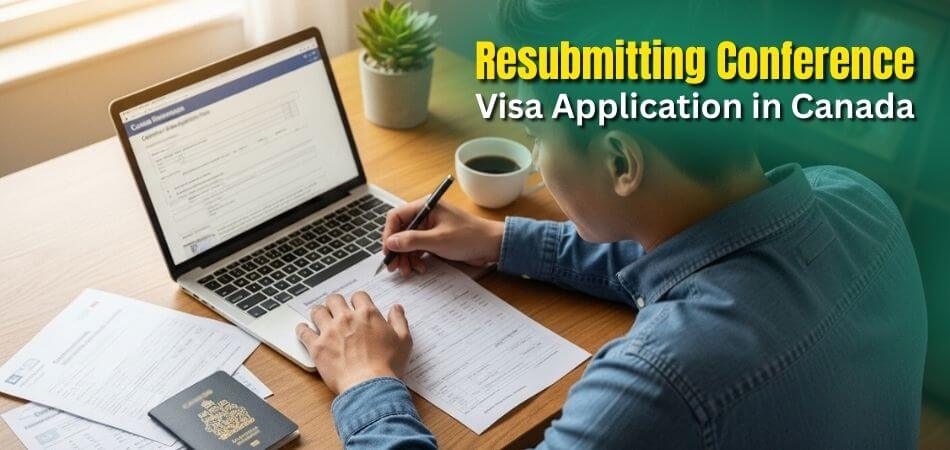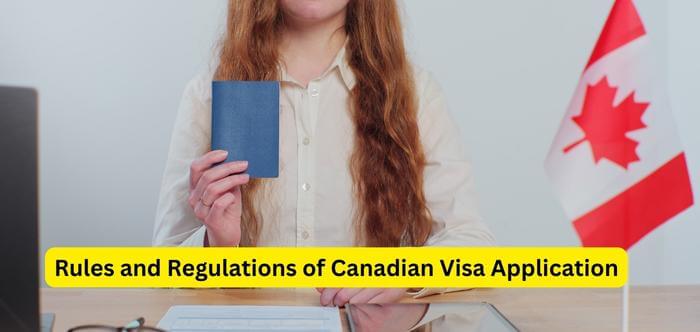Facing a visa refusal can be discouraging, especially when it stands in the way of attending an important conference in Canada. For many professionals, the opportunity to connect, share knowledge, and build networks is too valuable to let go.
This often raises the question, Can I resubmit my conference visa application in Canada? The short answer is yes, but success depends on more than just sending the same file again. A second application must directly address the concerns raised in the refusal letter, backed with stronger evidence and clearer explanations.
By taking the time to review your application carefully, update your documents, and prepare a stronger submission, you improve your chances of turning a refusal into an approval. With the right approach, resubmission can open the door to the conference experience you’ve been waiting for.
Can I Resubmit My Conference Visa Application in Canada?
Resubmitting your conference visa application in Canada is possible, but it only works if you carefully fix the issues that caused the refusal the first time. The key is to strengthen your file with updated information, clear evidence, and a well-prepared explanation. If you simply reapply with the same details, the result is very likely to be the same. Here’s how to make your resubmission stronger and more convincing.
Order GCMS Notes (if possible)
Before doing anything else, try to access the officer’s GCMS notes. These are internal notes that show why your application was refused. If you can get them, they will give you valuable insight into what exactly went wrong.
Fix Gaps with New Evidence
Carefully go through the refusal letter and gather stronger documents that answer those concerns. For example:
- Provide at least six months of updated bank statements to prove financial capacity.
- Attach your conference registration, acceptance letter, and event agenda to show the purpose of travel.
- Submit employment letters, property documents, or family obligations to confirm strong ties to your home country.
Draft a Cover Letter Addressing Refusal Points
A cover letter is your chance to directly speak to the visa officer. Keep it simple and professional. Below is a quick template you can adapt:
Cover Letter for Resubmission Sample:
[Your Full Name]
[Your Address]
[Date]
Visa Officer
Immigration, Refugees and Citizenship Canada
Subject: Resubmission of Conference Visa Application
Dear Visa Officer,
I am resubmitting my application for a Temporary Resident Visa to attend [Conference Name] in [City, Canada]. My initial application dated [Date] was refused due to [state reasons briefly].
To address these concerns, I am providing:
- [New evidence for financial stability]
- [Updated documents proving conference attendance]
- [Additional proof of strong ties to my home country]
I kindly request you to reconsider my application based on the corrected and updated information.
Sincerely,
[Your Name]
[Passport Number]
Check Biometrics Status
If you have given biometrics in the last 10 years, they are still valid. If not, you’ll need to provide them again. Make sure you check this in your IRCC account before submitting.
Submit New Application and Pay the Fee
Once all corrections are made, complete a new application form online, upload the updated documents, and pay the visa fee again (fees are non-refundable and must be repaid). After submission, track your application status on the IRCC portal, as Canada visa reapply processing time may vary depending on the volume of applications.
Resubmitting your conference visa application is more than just filling out the same form again; it’s about presenting a stronger, clearer, and more complete case. By reviewing the refusal reasons, adding convincing evidence, and writing a direct cover letter, you significantly improve your chances of approval. Careful preparation makes all the difference if you want to attend a conference in Canada and avoid facing another refusal.
Reapply vs. Reconsideration vs. Judicial Review (What’s Right for You?)
When a Canadian conference visa gets refused, most applicants wonder what to do next. The truth is, you have a few different paths available, and each works best in certain situations. Understanding these options clearly will help you choose wisely. Let’s walk through them together.
Quick Comparison Table
| Option | What It Means | When to Use |
| Reapply | Submit a brand-new application with updated information and documents. | Best if you have new or stronger evidence to fix the refusal reasons. |
| Reconsideration | Ask the same visa office to look at your file again if you believe a mistake was made. | Useful if the officer overlooked or misread something in your application. |
| Judicial Review | Take your case to the Federal Court to challenge the fairness of the refusal. | Last option if you believe the decision was unreasonable or unfair. |
Reapply
Reapplying is the most common choice and often the most practical. It gives you the chance to fix errors, provide stronger proof of funds, or add clearer evidence of your ties to your home country. Some applicants ask Can I withdraw my Canada visa application and reapply, and the answer is yes, but only if new and stronger documents are included. Reapplying with the same information almost always leads to another refusal.
Reconsideration
This option involves asking the visa office to look at your case again. It can work if you believe the officer overlooked a document or made a factual error. In such cases, some applicants try to write an appeal letter for Canadian conference visa refusals, but the proper method is usually to send a request through the IRCC webform. Keep in mind that reconsideration is not guaranteed and depends entirely on the officer’s discretion.
Judicial Review
Judicial review is a legal step where a Federal Court judge examines whether the refusal was reasonable. This process does not guarantee approval; it only checks if the decision was fair. It’s more complex, takes time, and usually requires a Canadian immigration lawyer. Most applicants consider this a last resort after other options have failed.
Choosing between reapplying, requesting reconsideration, or going for judicial review depends on your refusal reasons and the strength of your documents. Each path has its place, but knowing which one fits your situation can save you time, money, and stress.
How to Read Your Refusal Letter (and Turn It into a To-Do List)
Getting a visa refusal letter can feel discouraging, but it’s actually one of the most useful documents in the process. The letter lists the main reasons why your application was turned down, and each of those points becomes a clear task for your resubmission. By learning how to read it properly, you’ll know exactly what to fix. Let’s break it down step by step so you can turn those reasons into action.
Common Refusal Reasons
- Funds Not Sufficient: Visa officers need to see proof that you can cover all costs of your trip, including travel, accommodation, meals, and daily needs. Weak or outdated financial records often raise concerns about your ability to sustain yourself.
- Purpose of Visit Unclear: If your conference plans are not explained clearly, or if your invitation and agenda are missing, the officer may believe your travel purpose is vague. Without strong supporting evidence, your visit may appear uncertain.
- Weak Ties to Home Country: Officers must be convinced that you will return after the event. If your application doesn’t show steady employment, family commitments, or property ownership, they may suspect a risk of overstaying in Canada.
- Incomplete or Missing Documents: Even small gaps, like missing a bank statement, leaving a form incomplete, or failing to attach the conference confirmation, can result in refusal. Inconsistent or unclear paperwork gives the impression of an unreliable application.
Refusal Reason → Fix Matrix
| Refusal Reason | What It Means | How to Fix It in Resubmission |
| Insufficient funds | Officer doubts you can pay for the trip | Provide 6 months of updated bank statements and/or sponsor letter |
| Purpose of the visit is unclear | The conference’s reason is not convincing | Attach registration, agenda, and employer support letter |
| Weak ties to home country | Concern about not returning | Add proof of employment, family ties, property, or a return ticket |
| Incomplete documents | Missing key papers or details | Double-check the checklist, upload all required forms and confirmations |
Your refusal letter is not the end of the road; it’s a roadmap showing you what to improve. By carefully reviewing each reason and matching it with stronger evidence, you can build a much better case when you resubmit your application.
Compliance Checklist for Conference Visa Applicants
Applying for a Canadian conference visa requires more than just filling out a form; it’s about showing that every detail of your trip is properly planned and supported with the right documents. A complete checklist keeps you organized and reduces the chance of mistakes. Here’s a clear breakdown you can follow to prepare your file with confidence.
Quick Compliance Checklist
- Valid passport (minimum 6 months validity beyond travel)
- Invitation letter and confirmed conference registration
- Employer leave/support letter confirming role and return
- Proof of funds with a per-diem breakdown
- Travel itinerary and hotel booking confirmations
- Evidence of strong ties to home country (job, family, property, or studies)
Valid Passport
Your passport must remain valid for the entire duration of your stay in Canada. Ideally, it should extend at least six months beyond your return date to avoid issues during processing or travel. Always check expiry dates in advance.
Invitation Letter & Conference Registration
Attach the official invitation letter from the conference organizer along with your event registration. These documents confirm the purpose of your visit and reassure the officer that your travel is tied to a legitimate professional event.
Employer Leave/Support Letter
If you are employed, include a letter from your workplace granting leave and confirming your role, salary, and return date. This shows both your commitment to your job and your strong ties to your home country.
Proof of Funds with Per-Diem Breakdown
Financial stability is a key requirement. Provide updated bank statements and include a simple per-diem calculation of your trip costs, such as accommodation, meals, and travel. This proves you can manage expenses without difficulty.
Travel Itinerary & Hotel Booking
A clear itinerary that covers flight details, conference schedules, and hotel bookings helps demonstrate that your visit is well-planned. Confirmed reservations give credibility to your plans and remove any doubt about your intended movements.
Evidence of Strong Ties to Home Country
Show that you have solid reasons to return home after the conference. This could be proof of employment, property ownership, family commitments, or ongoing studies. Such evidence helps the visa officer trust in your return plans.
By preparing each of these checklist items carefully, you make your application stronger and easier for the officer to approve. Think of this as building a file that answers every question before it is even asked.
Common Mistakes and Solutions While Resubmitting Conference Visa Application
Resubmitting a Canadian conference visa application is not just about trying again; it’s about making sure you don’t repeat the same errors that caused your refusal. Many applicants unknowingly make small but serious mistakes during resubmission. Knowing how to correct a mistake on visa application and fix these issues can make your new application much stronger. Let’s look at the most common ones and how to handle them the right way.
- Mistake: Submitting the Same Documents Again Without Changes
Solution: Always update your file with new or stronger evidence. If funds were questioned, add recent bank statements; if your purpose was unclear, include updated conference registration and agenda. - Mistake: Ignoring the Refusal Letter Details
Solution: Read the refusal letter carefully and address each point directly. A cover letter that explains how you fixed every refusal reason shows the officer you took the feedback seriously. - Mistake: Not Proving Ties to Home Country
Solution: Strengthen your application with documents like an employment letter, property ownership papers, or family commitments. These clearly show that you plan to return after attending the conference. - Mistake: Providing Incomplete or Outdated Financial Proofs
Solution: Submit at least six months of updated bank statements, a sponsor’s financial support letter if applicable, and a simple cost breakdown. This reassures the officer that you can cover your expenses. - Mistake: Skipping Biometrics or Medical Requirements
Solution: Check if your biometrics are still valid (10 years). If not, be ready to submit them again. For longer stays, ensure medical exam requirements are completed and included. - Mistake: Rushing the New Submission
Solution: Take time to review everything twice. Even a small slip, like I made a mistake on my visa application Canada can cause problems. Double-check dates, spellings, and uploaded files before submitting to avoid refusal.
Mistakes during resubmission can cost time, money, and even your chance to attend an important conference. By understanding common errors and applying the right solutions, you improve your chances of a positive outcome with every new application.
Frequently Asked Questions
It’s natural to still have a few doubts after learning about resubmitting your conference visa application. Many applicants wonder about details that aren’t always obvious in official guides. Below are some of the most common questions people ask, along with clear and practical answers.
How Long Should I Wait Before Resubmitting My Visa Application?
There is no fixed waiting period for resubmission. A common doubt is when you can apply for a visa after rejection, and the answer is that you can reapply once you have new documents that address the refusal reasons. Waiting until you strengthen your case is always a smarter choice.
Can I Attend a Conference in Canada With a Visitor Visa Instead of a Specific Conference Visa?
Yes, most applicants use a visitor visa for conference travel. The key is to clearly show that your visit is business-related by attaching an invitation letter and proof of registration. This makes your purpose clear.
Do I Need to Hire a Lawyer for Resubmitting My Application?
Hiring a lawyer is not required, but it can help if your refusal reasons are complicated. Many applicants successfully resubmit on their own by carefully fixing the issues. Choose what feels right for your case.
Will a Past Refusal Affect My Future Applications to Canada?
A past refusal does not automatically harm future applications. What matters most is how well you address the officer’s concerns in your new submission. Providing stronger evidence usually improves your chances of success.
Can I Reapply Even if My Conference Date Is Very Close?
Yes, you can reapply, but timing is important because the visiting visa processing time often takes weeks. If your event is too close, you may not get a decision in time. Always plan well in advance.
Do I Need to Pay the Application Fee Again Each Time I Reapply?
Yes, each resubmission requires a new fee payment. The fee is non-refundable even if your first application was refused. This is why it’s important to fix mistakes before applying again.
Should I Include a Cover Letter With My Resubmitted Application?
Yes, a cover letter is highly recommended. It gives you the chance to directly explain how you fixed the refusal points and what new documents you are submitting. This makes your case stronger.
Concluding Note
Getting refused for a Canadian conference visa can feel disappointing, especially when you’ve been preparing to attend an event that matters for your career or studies. The good news is, a refusal doesn’t always mean the end of the road.
Many applicants ask, Can I resubmit my conference visa application in Canada? The simple answer is yes. But a successful second attempt depends on fixing the problems that caused the refusal. Sending the same file again will almost always lead to another rejection.
By reviewing your refusal letter carefully, updating your documents, and explaining your case clearly, you can present a much stronger application. With proper preparation, resubmission gives you a real chance to turn a refusal into an approval.








